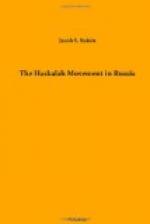In the cities, though the pan’s excesses were bound to be somewhat bridled there, the lot of the Jews was equally gloomy. They were treated like outlaws, were forbidden to engage in all but a few branches of trade or handicraft, or to live with Christians, or employ them as servants. In 1720 they were prohibited to build new synagogues or even repair the old ones. Sometimes the synagogues were locked “by order of ...” until a stipulated amount of money bought permission to reopen them. We of to-day can hardly imagine what pain a Jew of that time experienced when he hastened to the house of God on one of the great Holy Days only to find its doors closed by the police!
Their status was no better in Lithuania and Great Russia. The accession of Ivan IV, the Terrible (1533-1584), dealt their former comparative prosperity a blow from which it has not recovered to this day. As if to remove the impression of liberalism made by his predecessor and obliterate from memory his amicable relations with Doctor Leo, de Guizolfi, and Chozi Kolos, this monster czar, with the fiendishness of a Caligula, but lacking the accomplishments of his heathen prototype, delighted to invent tortures for inoffensive Jews. He expelled them from Moscow, and deprived them of the right of travel from place to place. During his occupancy of Polotsk he ordered all Jews residing there either to become converts to Greek Catholicism or choose between being drowned in the Dwina and burnt at the stake.
But even the removal of the terrible czar and the dawn of the century of reason and humanitarianism failed to effect a change for the better in the condition of the Slavonic Jews. For a while it appeared as if the Zeitgeist might penetrate even into Russo-Poland, and the Renaissance and the Reformation would not pass over the eastern portion of Europe without beneficent results. In Lithuania Calvinism threatened to oust Catholicism, science and culture began to be pursued, and Jewish and Gentile children attended the same schools. The successors of Ivan IV were men of better breeding, and the praiseworthy attempts of Peter the Great to introduce Western civilization are known to all.[3] But Slavonic soil has never been susceptible to the elevating influences that have transformed the rest of Europe. Every reformatory effort was nipped in the bud. The lot of the Jews accordingly grew from bad to worse. In 1727 they were expelled from the Ukraine and other provinces, and they were recalled, “for the benefit of the citizens,” only at the instance of Apostol, the hetman of the very Cossacks that had massacred them in 1648. Baruch Leibov was burned alive in St. Petersburg, in 1738, for having dared “insult the Christian religion by building a synagogue in the village of Zvyerovichi,” an offence that was aggravated by the suspicion that he had converted the Russian Captain Vosnitzin to Judaism. The same fate was, in 1783, meted out to Moses, a Jewish tailor, for refusing to accept Christianity, and in




